Demon Spawn – Artificial Wombs in Ancient India
Demon Spawn – Artificial Wombs in Ancient India
The Mahabharata foretold synthetic wombs, leftoid lunacy, and nuclear bombs. Hindus revere their ancient “seers” for a reason
Last week, the German bio-propagandist Hashem Al-Ghaili shocked the world with his concept video EctoLife: The World’s First Artificial Womb Facility. The shot opens on a designer baby factory, then pans across rows of steel womb-pods. The little miracles inside are tended by AI modulators and faceless nurses in hazmat suits.
Seeing these “30,000 lab-grown babies” packed together in tiered grids, it was like I could smell the fresh bleach on top of stale piss.
“With EctoLife, miscarriage and low sperm count are a thing of the past,” the chatbot narrator promises. “Prior to placing the fertilized embryo of your baby inside the growth pod, in vitro fertilization is used to create and select the most viable and genetically superior embryo, giving your baby a chance to develop without any biological hurdles.”
What sort of unfit mother could say no to that?
Besides, with global sperm counts plummeting and gay marriage rising, these eugenic EctoLife pods may be the only Future™ that humanity can hope for. That’s the sales pitch, anyway.
The ad’s dismal set is suspiciously reminiscent of the pink pod scene in the The Matrix, where Neo awakens to the reality that human beings are nothing more than bio-batteries used to power an artificial intelligence swarm.
Even more so, the rows of synthetic wombs remind me of another classic—the ancient Hindu epic, the Mahabharata. Compiled around 2,200 years ago from far older sources, the entire text is roughly 15 times the length of the Bible. It’s also the first myth, so far as I know, to feature a pod-baby production line.
As a whole, the Mahabharata is a brilliant latticework of stories within stories, filled with blood feuds and bad omens, hurtling toward cosmic disintegration, and laced with more metaphor and hyperbole than a womanizing Hebrew warrior hacking off two hundred Philistine foreskins to win the king’s lovely daughter.
The epic culminates in an apocalyptic war between the mostly good princes, the Pandavas, and their relatively wicked cousins, the Kauravas. As with many heroes of yore, the former were born of chaste women impregnated by the gods. The latter, being fairly demonic, were gestated in artificial wombs and born under a bad sign.
The Kauravas were the descendants of a blind king and his devoted wife, Gandhari, who was so devoted to her husband, she blindfolded herself for life. Despite this inauspicious arrangement, she was promised by a seer that she would conceive a hundred sons.
The most accessible version of this story comes from William Buck’s beautiful retelling (slightly edited here for simplicity’s sake):
The seer Vyasa came to the king and said, “Gandhari carries one hundred sons. She will give birth at the end of two years. Be patient and know that there is no danger to her, and I will return when it is time.”
Vyasa then spoke with the prince, Bhishma, so that when Gandhari gave birth there were a hundred bronze jars filled with clear butter (ghee), ready and hidden in the palace garden. From her womb came a hard ball of flesh that Vyasa took from her and washed in cool water.
Everyone at the palace was disgusted by this monstrous birth. It was clear the royal dynasty had been tainted by something impure and unnatural:
“Here are your hundred sons,” he told Gandhari, “But there is more to do before they are formed.”
Vyasa divided that ball of flesh into pieces, about the size of a thumb. As he worked in the garden, Bhishma put each piece into a jar and sealed it. At the end there was an extra piece.
Bhishma brought another jar and Vyasa said, “There are now one hundred sons and one daughter. See that the jars are not opened for two more years; then they will be born.”
The firstborn was Duryodhana. He emerged from his jar dripping with ghee and “braying like an ass.” In response, donkeys, jackals, and crows all over the kingdom wailed in terror. Then came the storm winds. One by one, the next hundred jars were cracked open.
These portents proved fatal. The Kauravas would go on to get the entire kingdom killed in a genocidal war. On a more cosmic scale, these unholy jar-babies foreshadowed cosmic degeneration and the coming dark age—the Kali Yuga, or “Age of the Black Goddess.”
The mythic insight in the Mahabharata still guides a billion lives today, from pious Hindus to flaky New Age gurus. In a similar fashion, the pod-people fantasy laid out in EctoLife—in addition to every other wave of tech propaganda—is one of many potential futures reaching back in time to capture the present.
Both of these imaginative realms—the ancient and the futuristic—are being gradually actualized through advancing technology.
Embryo selection following in vitro fertilization is currently practiced by parents all over the developed world. Scientists have already employed “bio-bags” to successfully gestate premature lambs. CRISPR gene-editing tools have allegedly been used to enhance a pair of twins in China—and perhaps other infants in secret labs out of public view.
OpenAI co-founder Sam Altman has invested in various reproductive tech start-ups, including Conception, which aims to allow gay men to conceive by inserting one parent’s sperm chromosomes into an egg.
Earlier this year, Ethereum crypto co-founder Vitalik Buterin suggested using synthetic wombs to liberate mothers-to-be from the costs of childbirth.

These ungodly notions, once isolated to the transhuman fringe, are creeping into the mainstream in the corniest forms imaginable. USC student Timothy Wang, writing in a university publication, is a prime example of this reckless launch from the biosphere:
Although artificial wombs won’t fix every problem caused by sexism, the technology...could allow the birth of a child without risking the potential health and career hazards that come with being pregnant. … With artificial womb technology, same-sex couples, transwomen, and women whose uteruses had to be removed for health reasons could have a child without adoption or surrogacy.
This isn’t just another wacky argument for “equity.” This is spiritual warfare against the essence of motherhood and what it means to be human.
In the Hindu reckoning of time, the universe ebbs and flows through repeating cycles. Each one begins with a primordial golden age and descends into degenerating states, always followed by a renewal. This process unfolds in four ages, or “yugas,” the last being the Kali Yuga, named for the Black Goddess of Destruction.
During the Kali Yuga, all social hierarchies are upended. The lowest type dictates the behavior of the highest. Everywhere, fools be trippin’.
Reading descriptions in the Vishnu Purana, composed in the early first millennium AD, one finds them eerily relevant to the modern world. The following were highlighted by the grouchy, if always insightful esotericist, Julius Evola:
Outcastes and barbarians will be masters on the banks of the Indus...kings of violent temper. … They will seize upon the property of their subjects; they will be of limited power and will for the most part rapidly rise and fall; their lives will be short, their desires insatiable, and they will display but little piety. The people of various countries intermingling with them will follow their example. …
The prevailing caste will be the [servant] Shudra. …
Vaisyas [the middle class] will abandon agriculture and commerce and gain a livelihood by servitude or the exercise of mechanical arts. …
Kshyatrias [the rulers] instead of protecting will plunder their subjects; and under the pretext of levying customs will rob merchants of their property. … Then property alone will confer rank; wealth will be the only source of devotion; passion will be the sole bond of union between the sexes; falsehood will be the only means of success in litigation. …
Earth will be venerated but for its mineral treasures. …
Morality becomes a matter of expedience. Everything sacred is made profane. The trajectory is ever downward:
In the Kali age, men corrupted by unbelievers...will say: “Of what authority are the Vedas [sacred scriptures]? What are gods or Brahmans [priests]?” …
Men will fix their desires upon riches, even though dishonestly acquired. …
The women will pay no attention to the commands of their husbands or parents. … They will be selfish, abject and slatternly; they will be scolds and liars; they will be indecent and immoral and will ever attach themselves to dissolute men.
And so on, and so forth. After awhile, you wonder why they didn’t call it the Complainer Yuga.
Like its counterparts in Israel and China, ancient India was fiercely traditionalist. For these people, the worst imaginable future was one where the caste structure slips and sacred boundaries dissolve. Upon encountering Hindu culture during the colonial period, the Euros were awed, and often revolted, by its rigid customs. Naturally, they set about modernizing it.
As the wheel of karma turns westward, though, it’s easy to imagine a Kali Yuga checklist for modern America:
Mexican cartels will be masters of the Rio Grande. Polar bears will be hunted in the streets. Bankers will steal your soul to sell it back to you, and politicians will tax the sale.
Drag queens will read storybooks to pod-babies. Men will fight make believe enemies on screens. Women will get tacky tattoos. Everyone will whoop it to porn.
Every brain will be chipped like a circuit board. The godless will preach the Rainbow Machine from every pulpit.
Dogs and cats—living together! Mass hysteria!!
The story of the Mahabharata, set thousands of years ago, concludes with the onset of the Kali Yuga. The cataclysmic war fought by the Pandava princes (led by the demigod Arjuna) against their Kaurava cousins (led by the jar-baby Duryodhana) signals a cosmic descent into darkness and spiritual squalor.
Despite Arjuna’s crushing guilt, he’s upbraided by his chariot-driver, Krishna, who turns out to be God incarnate. Krishna instructs the warrior to wipe his demonic enemies off the face of the earth. In the process, most of his allies will also perish, but it doesn’t matter. A warrior’s duty—his “dharma”—is to fight.
(This famous episode is contained in the Bhagavad Gita, familiar to many Westerners thanks to the robed Hare Krishnas who used to dance around our airports.)
As the heroic Arjuna hesitates, worried that killing his own family will bring on bad karma, Krishna suddenly reveals his own “supreme supernal form” which is “God himself, infinite and universal, containing all miracles”—the Creator, the Preserver, and the Destroyer.
The Lord’s message is simple. Do not fear death, and do not shrink from your duty to fight. All mortal bodies are fated to die. In the end, nothing matters but your eternal soul.
The divine vision was as terrifying as a mushroom cloud. From the Bhagavad Gita:
If in the sky the light of a thousand suns were to rise at once, it would be the likeness of the light of that great-spirited One. In that body of the God of Gods, the Pandava [Arjuna] saw the entire universe centered, in its infinite differentiations. ...
Arjuna said:
I see all Gods in your body, O God,
And all creatures in all their varieties…
Your own infinitude stretching away,
Many arms, eyes, bellies, and mouths do I see,…
Watching your mouths that bristle with fangs
And resemble the fire at the end of the eon....
As moths on the wing ever faster will aim
For a burning fire and perish in it,Just so do these men increasing their speed
Make haste to your mouths to perish in them.…
The Lord said:
I am Time grown old to destroy the world.
Embarked on the course of world annihilation.
In this ultimate vision, all the sins of a degenerate age are purged by a cleansing fire at the heart of existence.
Two elements of this ancient epic have always fascinated me—the fatalistic cosmology coupled with a remarkable intuition of future technology. You don’t have to convert to Hinduism to appreciate its insight. In fact, I’d make fun of you if you did. There’s nothing more ridiculous than a Westerner running around with a bindi on his forehead.
The concept of the Kali Yuga, of inevitable degeneration leading to renewal, defies modern ideals of “progress.” In this view, liberalism and social disruption are not advancement. They are merely phases in a steady fall from grace. On the other side of that subversion of the natural order is the promise of restoration—at least temporarily.
The drawback is that this renewal requires total destruction. Which brings us to the technological element.
As with many ancient myths, we find various magical devices in the Mahabharata that resemble modern technology. There are the bronze jars serving as artificial wombs. There are the vimanas—airborne chariots that fly at the speed of wind.
The most powerful device is the Brahmastra—a homing arrow so powerful, it is capable of engulfing the entire world in flames. Upon impact, the brahmastra will cause the glaciers to melt, the sea to boil, and the earth to tremble. Wherever it detonates, nothing will ever grow there again. Once fired, this magic missile cannot be recalled.
Every perceptive scholar who reads about the Brahmastra sees the same thing—a premonition of the nuclear warhead.
It’s only natural, then, that when the “father of the atomic bomb,” Robert Oppenheimer, saw his baby explode on the New Mexico desert in 1945, a grim passage from the Bhagavad Gita came to mind.
“Now I am become Death, the destroyer of worlds.”
None of us know the future. It can only be explored through more or less accurate fantasies. If we’re honest, most of us barely understand the present—the reality right in front of our faces—and even the recent past recedes into more or less useful mythologies.
Given that cloud of unknowing, we can only project utopias, total devastation, or boring stability just ahead of us. Yet as we watch the world progress into increasingly elaborate perversions, transforming the natural order into mechanistic chaos, the ancient myths of a cleansing inferno seem more relevant by the day.
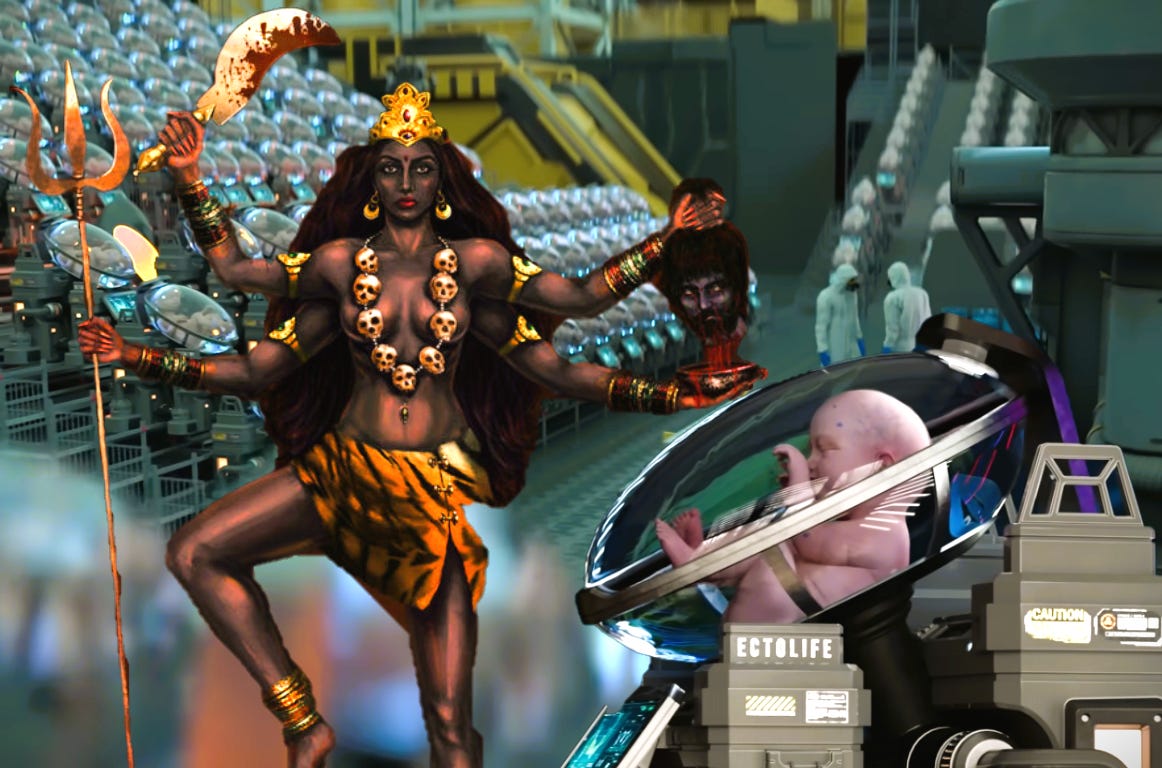


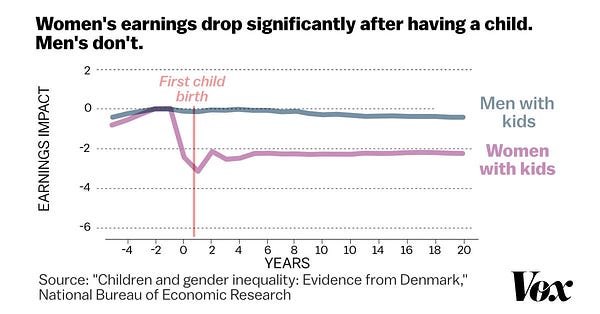
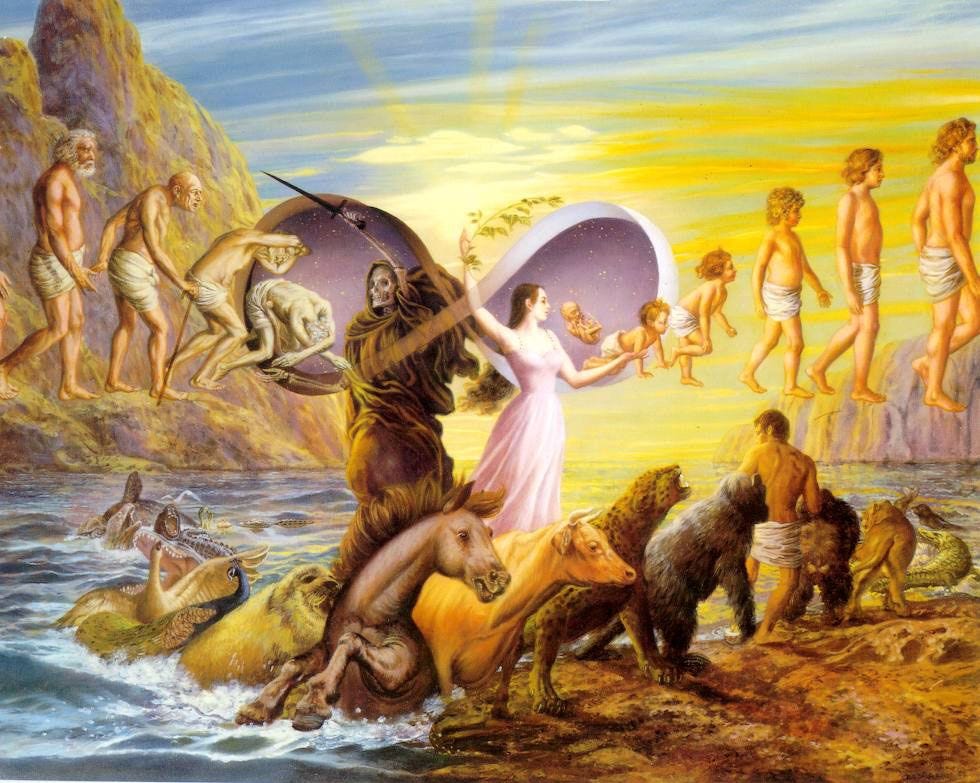
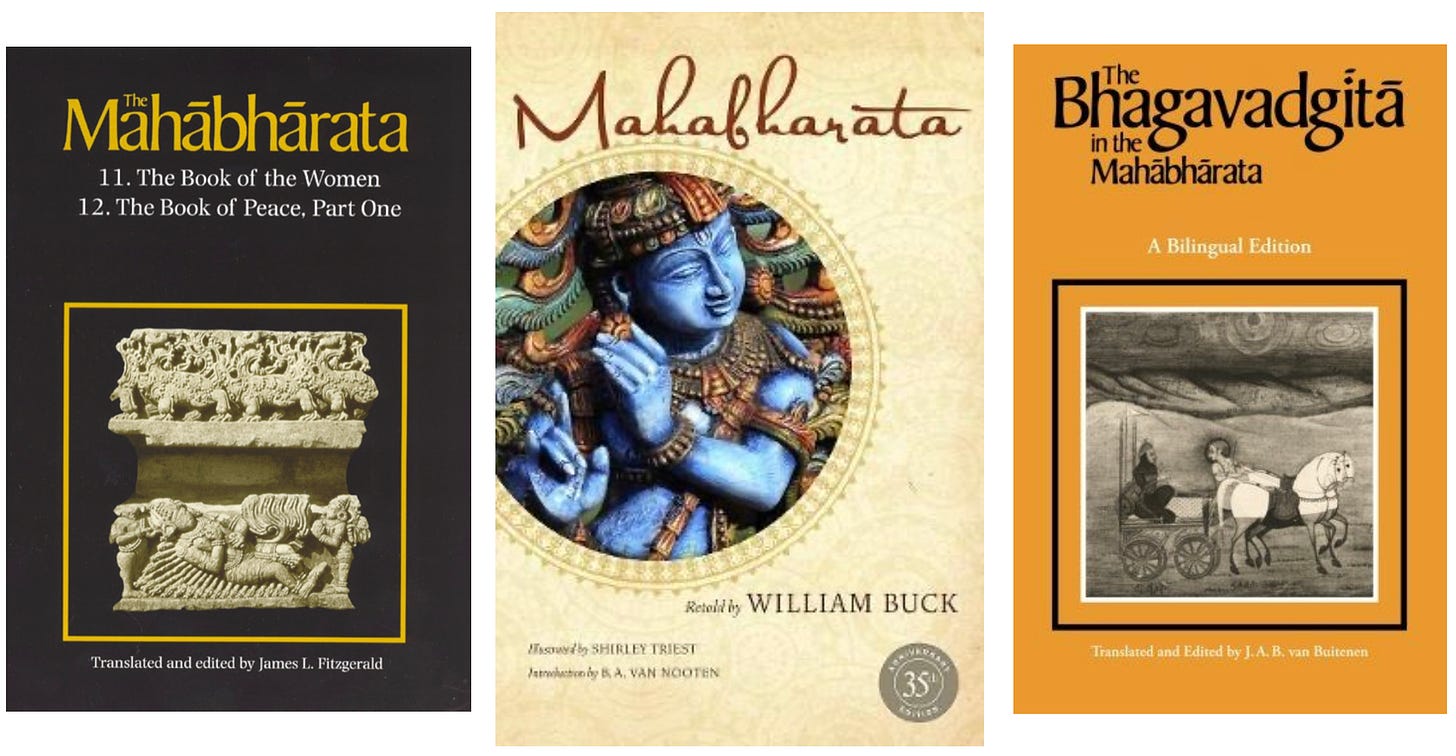
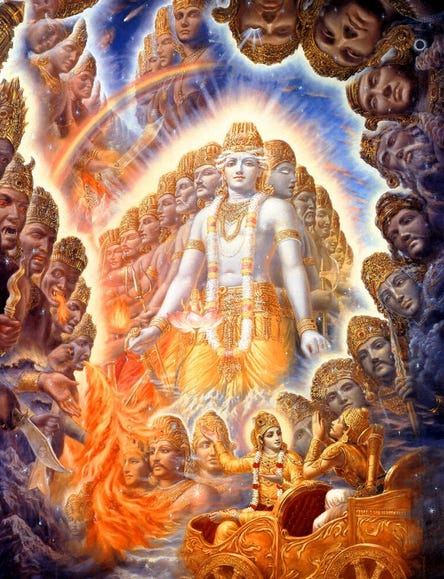
Comments
Post a Comment